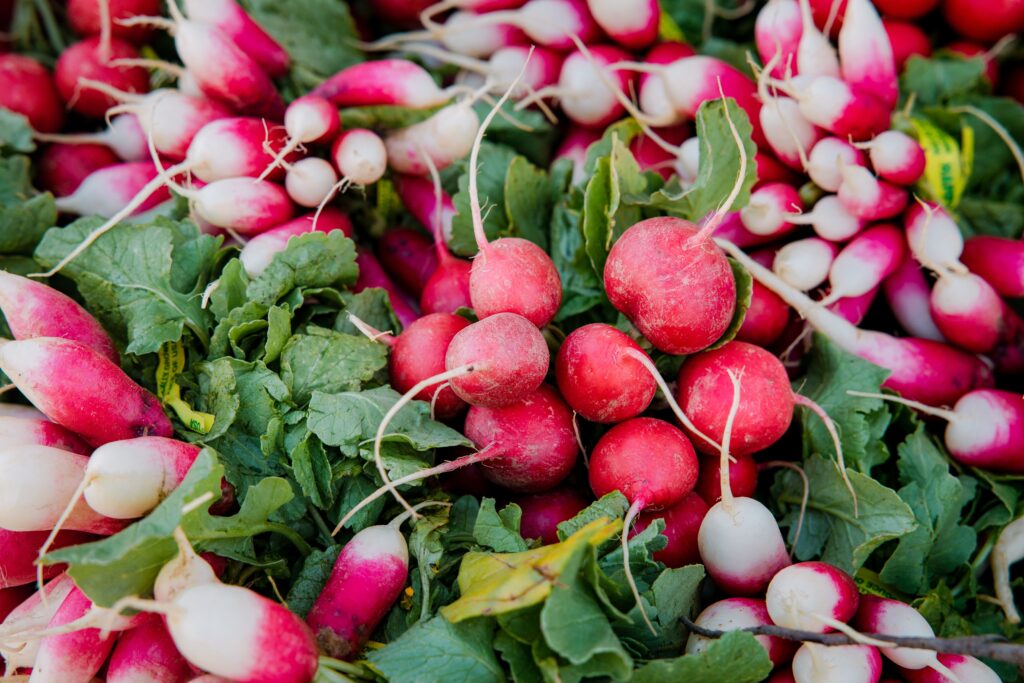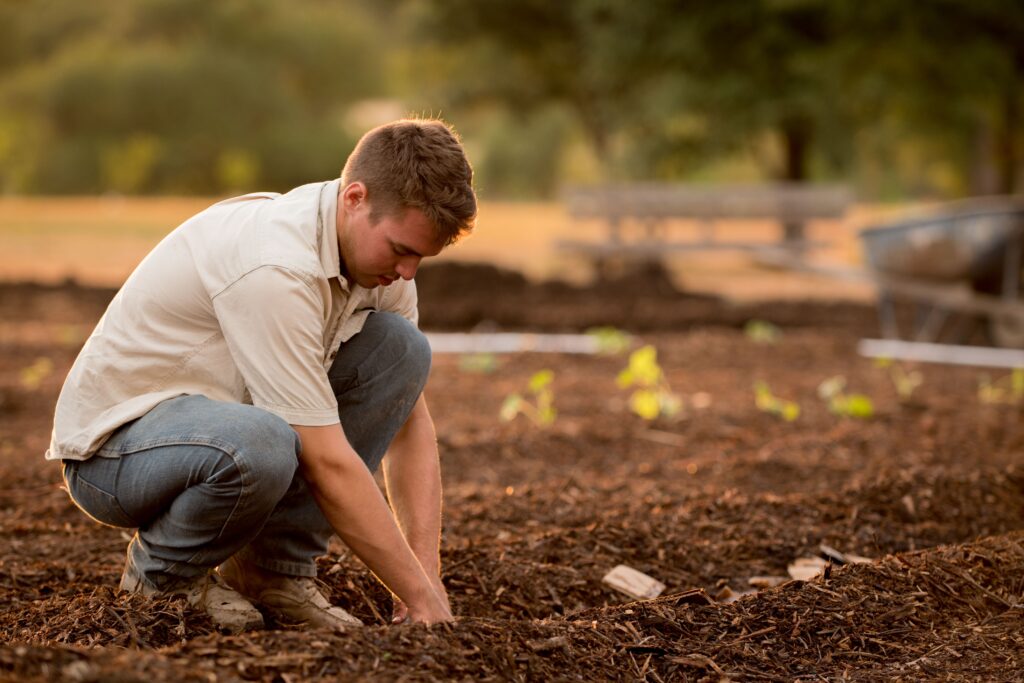
Source: Author
6/June/2023 by Sophie
As the season begins and our gardens come to life, it’s an exciting time to indulge in the joys of homegrown produce. Among the first vegetables ready to harvest right now are radishes. As one of our first gardening attempts, my friends and I decided to try our luck with the French breakfast radish. This variety has a quick maturation time of just 3-4 weeks, making it a great crop to learn from because you can have quite a few successions in one season. Plus, if you mess up and end up with just leaves, this plant is 100% edible, so at least you can get a nice salad out of the leaves! With a myriad of varieties to explore, I find radishes to be an excellent choice for new gardeners.
A brief breakfast-y, radish-y history
The French breakfast radish has an elongated and cylindrical shape, with vibrant red skin that transitions to crisp white at the ends. French Breakfast is an early/spring variety, which means it prefers cooler temperatures and has a milder flavour than other midseason/summer or late season/winter radishes. The interior white flesh reveals a mild peppery flavor, and it’s high water content ensures a satisfying crunch from every bite.
These delightful spring radishes have a long history, and were a popular staple in French gardens and markets by the late 19th century, notably in Parisian farmer’s markets. But it wasn’t the French who were eating these guys for breakfast. In fact, as the story goes, the Victorian English really loved eating this variety for breakfast during a radish festival. As an homage to their country of origin, this variety came to then be known in upper-class English circles as French Breakfast radishes.
Planting – Setting Yourself Up for Success
To ensure a successful radish-growing experience, it’s really important to pay attention to sowing time details. The timing of sowing depends on the variety and soil temperature. For early varieties like French Breakfast Radishes, you should be sowing in early spring or late summer to try and avoid those days above 20 degrees. Soil quality plays a role, too – make sure your soil is well-draining and rich in organic matter, and avoid using fertilizers rich in nitrogen. Be sure to sow your seeds deep enough (check your seed packet – I’ve found half an inch works for French Breakfast). Don’t be scared of overseeding, you can thin your radishes out once they germinate.

Source: Jason Leung via Unsplash
Growing
Once your radishes have sprouted, thinning out seedlings is essential to allow adequate space for each radish to fully develop. I try to space seedlings out every 3-5 inches, or about the width of my palm.
Because we harvest their roots when they are young and tender, radishes remain in the top layers of our soil, so they prefer shallow and frequent watering, instead of lots of water at one time. If they don’t get enough water, radishes can become pithy. And if they get too much water at once, they just might split.
Along the way, we must be mindful of common pests and diseases by always observing our plants. With all pests, the best thing you can do for your plant is keep it well-watered and cool. Stressed plants have a harder time fighting off attacks from pests. My top three radish pests last year were aphids, black rot, and flea beetles.
Be on the lookout for aphids in the spring and early Summer, when your plants are tiny. If less than a quarter of my plant’s leaves are affected by aphids, I usually let them be, or I squish them with my hand if their population seems to increase really fast. You can check out my blog post on Aphids to learn more about my pest control tips for our tiny friends.
Black root rot is something you will see on radishes with poor-draining soil. If you have a nice layer of clay soil under your radishes, water won’t be able to penetrate this layer, and your radishes will start to rot from the prolonged water contact. This is why proper draining is really important when trying to prevent rot.
Flea beetles are lovers of all things Brassicaceae. Brassicas are a group of vegetables that include things like mustards, cabbages, cruciferous vegetables, and our lovely lovely radishes. If you have a bunch of tiny holes in your radish leaves, flea beetles could be the culprit. Just like aphids, if less than a quarter of my plant’s leaves are affected by flea beetles, I usually let them be. But when we have an early spring and a dry summer, you can start to suspect that the flea beetle population in you garden will grow easily.
Using floating row covers at the beginning of the season before you see any flea beetles can help reduce your plant’s exposure to flea beetles. If you do notice a large amount of your leaves and stems being eaten, bring a bowl of soapy water to the garden and shake your plants over it. Adding soap lowers the water’s surface tension, and the flea beetles that fall into the water won’t be able to float on the water only to return to your crops once again.

Source: Jed Owen via Unsplash
Harvesting and storing
Timing is everything when it comes to harvesting French breakfast radishes, which take about 25-30 days to mature. Waiting too long can result in oversized radishes with a woody texture and an intensified peppery taste. An easy way to assess maturity without damaging them is by inserting a finger into the dirt next to the radish, and evaluating its size. When they reach the desired stage, harvest them by giving a gentle twist and pull.
For short-term storage, remove the leaves and trim the roots, then wrap the unwashed radishes in a moist paper towel and store them in the refrigerator. For longer-term storage, consider pickling them to savor their flavors in the months to come.
Enjoying the harvest
Although the name “breakfast” might suggest a morning meal, I’m more of a radishes at lunch or snacktime type of gal. While I could suggest a salad, which would be delicious, I don’t really use radishes that way.
If you want to try enjoying radishes French-style, try “Radis Beurre”. All you need is four simple ingredients: Radishes, butter, salt, and bread. Slice one end of the radish so you can add some butter, and dip the radish in a bit of salt. The bread is served on the side. The idea is to bit the radish, and then take a bite of bread. I kind of put my own Canadian twist on Radis Beurre by turning it into an open-face sandwich – I toast the bread, spread some salted butter on top, and then add a few slices of radish to it. Delicious!
You can also use the leafy greens into a vibrant pesto for a nice peppery spread. You can either completely replace the basil, or switch a bit of the basil you need for some nice radish greens!
Or, if you’re looking for a simple and snack to pair with a beer in the park, try dipping a freshly harvested radish in some salt and savor their raw texture. Sometimes the best things in life are the simplest :).
What’s your favourite way to eat radishes? Let us know in the comments!

Source: Louis Hansel via Unsplash
